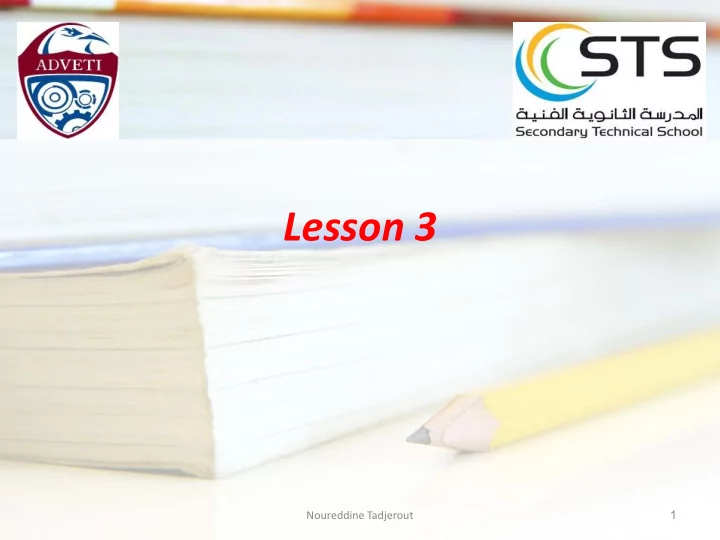

Lesson 3 1 Noureddine Tadjerout
System Board Components • Chipsets • Expansion slots • Memory slots and external cache • CPU and processor slots or sockets • Power connectors • Onboard disk drive connectors • Keyboard connectors • Peripheral port and connectors • BIOS chip • CMOS battery • Jumpers and DIP switches • Firmware 2 Noureddine Tadjerout
Memory Slots and External Cache • Memory (RAM) slots are slots on a motherboard ,they contain the modules that hold memory chips that make up primary memory, • the memory used to store currently used data and instructions for the CPU. 3 Noureddine Tadjerout
Form Factors for the most popular memory chips 4 Noureddine Tadjerout
• Small metal or plastic tabs on each side of the slot keep the memory module securely in its slot. virtual RAM cache memory 5 Noureddine Tadjerout
Central Processing Unit (CPU) and Processor Socket or Slot • The “brain” of any computer • usually the component that has either a fan or a heat sink 6 Noureddine Tadjerout
7 Noureddine Tadjerout
8 Noureddine Tadjerout
9 Noureddine Tadjerout
10 Noureddine Tadjerout
11 Noureddine Tadjerout
Socket T or Socket LGA 775 The land grid array (LGA) 12 Noureddine Tadjerout
13 Noureddine Tadjerout
14 Noureddine Tadjerout
zero insertion force (ZIF) sockets • Modern CPU sockets have some sort of mechanism in place that reduces the need to apply the considerable force to the CPU that was necessary in the early days of personal computing to install a processor. 15 Noureddine Tadjerout
Power Connectors 16 Noureddine Tadjerout
17 Noureddine Tadjerout
Onboard Floppy and Hard Disk Connectors • drive interfaces • There are two main types: • floppy drive interfaces • hard disk interfaces. • onboard, as opposed to being on an expansion card (off-board). – SATA, – Scsi 18 Noureddine Tadjerout
IDE hard disk interfaces. (off-board). 19 Noureddine Tadjerout
IDE hard disk interfaces. (on-board). 20 Noureddine Tadjerout
Sata interfaces. (off-board) 21 Noureddine Tadjerout
Sata interfaces. (on-board) 22 Noureddine Tadjerout
Scsi interfaces. (off-board) 23 Noureddine Tadjerout
Scsi interfaces. (in-board) 24 Noureddine Tadjerout
Keyboard Connectors AT PS/2 connectors • 5-pin DIN • 6-pin mini-DIN • green connectors on mice and the keyboard connectors are purple. 25 Noureddine Tadjerout
Wireless keyboard and mouse Bluetooth technology or a proprietary RF implementation 26 Noureddine Tadjerout
USB-attached keyboards 27 Noureddine Tadjerout
Peripheral Ports and Connectors DC power in Analog modem RJ-11 Ethernet NIC RJ-45 S-video out DVI-D out SVGA out Parallel (on top) Standard serial Mouse (on top) Keyboard S/PDIF (out) 28 Noureddine Tadjerout USB
A game port & Sound card jacks 29 Noureddine Tadjerout
Motherboard Attachment • header connection • Direct-solder method 30 Noureddine Tadjerout
31 Noureddine Tadjerout
32 Noureddine Tadjerout
BIOS Chip • BIOS is an acronym for Basic Input/Output System • It is the boot firmware program on a PC that controls the computer from the time you start it up until the operating system takes over. • When you turn on a PC, the BIOS first conducts a basic hardware check, called a Power-On Self Test (POST), to determine whether all of the attachments are present and working. • Then it loads the operating system into your computer's random access memory, or RAM. • The BIOS also manages data flow between the computer's operating system and attached devices such as the hard disk, video card, keyboard, mouse, and printer. • The BIOS stores the date, the time, and your system configuration information in a battery-powered, non-volatile memory chip, called a CMOS (Complementary Metal Oxide Semiconductor) after its manufacturing process. 33 Noureddine Tadjerout
Firmware firmware Software encoded on hardware. The BIOS routine and its chip is an example of firmware the chip usually has a sticker or printing on it from one of the major BIOS manufacturers (AMI, Phoenix/Award, Winbond, and so on) 34 Noureddine Tadjerout
35 Noureddine Tadjerout
CMOS Battery • Date • Time • Hard drive configuration • Memory • Your PC keeps these settings in a special memory chip called the Complimentary Metal Oxide Semiconductor (CMOS) chip. • Actually, CMOS (usually pronounced see-moss ) is a type of memory chip; • The BIOS starts with its own default information and then reads information from the CMOS, such as which hard drive types are configured for this computer to use, which drive(s) it should search for boot sectors, and so on. • Any overlapping information read from the CMOS overrides the default information from the BIOS. 36 Noureddine Tadjerout
What's the difference between BIOS and CMOS? • The BIOS is the program that starts a computer up, and the CMOS is where the BIOS stores the date, time, and system configuration details it needs to start the computer. • The BIOS is a small program that controls the computer from the time it powers on until the time the operating system takes over. The BIOS is firmware, which means it cannot store variable data. • CMOS is a type of memory technology, but most people use the term to refer to the chip that stores variable data for startup. A computer's BIOS will initialize and control components like the floppy and hard drive controllers and the computer's hardware clock, but the specific parameters for startup and initializing components are stored in the CMOS. 37 Noureddine Tadjerout
38 Noureddine Tadjerout
39 Noureddine Tadjerout
Jumpers and DIP Switches • These two devices are used to configure various hardware options on the motherboard. • For example, some processors use different voltages 40 Noureddine Tadjerout
41 Noureddine Tadjerout
Recommend
More recommend